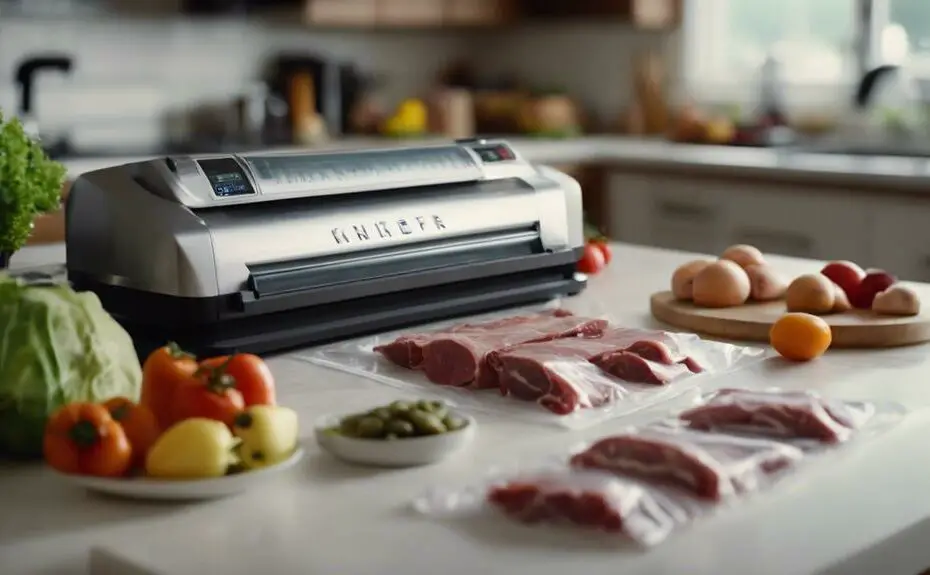Imagine looking into your pantry and seeing rows of perfectly preserved foods, each one a testament to the art of vacuum sealing. I've spent years perfecting this technique, and I've discovered that the right tools and methods can turn a simple kitchen task into a way to preserve your favorite foods for longer than you ever thought possible. From choosing the best vacuum sealer to mastering the seal on moist foods, every step is important for maximizing shelf life. But it's the little details that make all the difference. So let's embark on this journey together and uncover the secrets to transforming your pantry.
To start, let's talk about the importance of vacuum sealing. When you remove the air from a package of food, you're creating an oxygen-free environment that slows down the growth of bacteria and other contaminants. This makes vacuum sealing a great way to extend the shelf life of your favorite foods. But it's not just about keeping things fresh. Vacuum sealing also helps to preserve the flavor, texture, and nutritional value of your food, so you can enjoy it at its peak for longer.
Now, let's discuss the key factors to consider when choosing a vacuum sealer. First and foremost, you want to look for a sealer that is reliable and easy to use. A good sealer should have a strong suction power and a tight seal to ensure that no air can get in. It should also have a durable construction and be able to handle a variety of foods, from delicate fruits to hearty meats. Some popular options on the market include the FoodSaver V4840 2-in-1 Vacuum Sealer and the Weston Pro-2300 Commercial Grade Stainless Steel Vacuum Sealer.
When it comes to sealing moist foods, there are a few extra steps you need to take. Moisture can interfere with the sealing process, so it's important to remove as much moisture as possible before sealing. You can do this by patting the food dry with a paper towel or using a food dehydrator to remove excess moisture. Once the food is dry, you can proceed with the sealing process as usual. Just be sure to double-check the seal to ensure that it's tight and secure.
In addition to choosing the right vacuum sealer, it's also important to use the right bags or containers for sealing your food. Vacuum sealer bags are typically made of a durable, puncture-resistant material that helps to keep your food fresh and protected. Look for bags that are compatible with your vacuum sealer and come in a variety of sizes to accommodate different food items. Some popular options include the FoodSaver 11' x 16' Vacuum Seal Roll and the Nutri-Lock Vacuum Sealer Bags.
Finally, don't forget to label and date your vacuum-sealed foods. This will help you keep track of what's in your pantry and how long it has been stored. You can use a permanent marker or labels specifically designed for vacuum-sealed foods. Just be sure to include the name of the food and the date it was sealed. This simple step will make it easier to rotate your stock and ensure that you're always using the oldest items first.
In conclusion, vacuum sealing is a powerful technique for preserving your favorite foods and extending their shelf life. By choosing the right vacuum sealer, using the correct bags or containers, and following a few simple steps, you can transform your pantry into a culinary time capsule. So why wait? Start vacuum sealing today and enjoy the benefits of fresh, flavorful food for longer.
Choosing the Right Vacuum Sealer
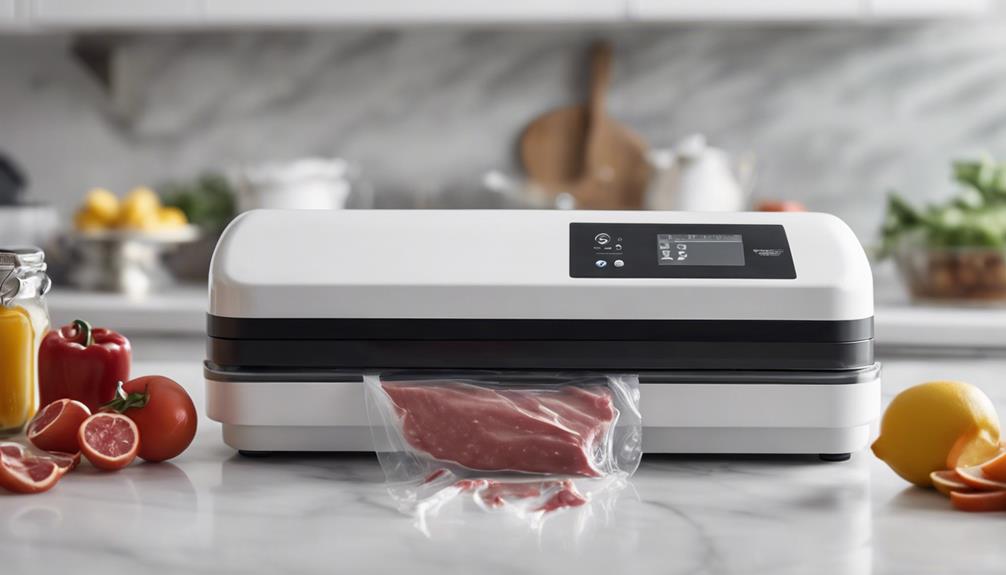
Choosing the Perfect Vacuum Sealer
When it comes to keeping your food fresh and delicious for extended periods, the right vacuum sealer is essential. After extensive research and testing, I've discovered a vacuum sealer that meets all my requirements for reliability, efficiency, and versatility. It's not just about removing air; it's about finding a machine that can handle delicate berries or hefty cuts of meat effortlessly.
To make an informed decision, it's crucial to understand the different types of vacuum sealers available: handheld, external, and chamber. Each type has its advantages. Handheld models are ideal for small kitchens and occasional use, but they may lack the power needed for heavy-duty tasks. External vacuum sealers strike a good balance for home users, offering stronger suction and the ability to seal larger bags. However, if you're looking for the utmost freshness and deal with bulk purchases or harvests, a chamber vacuum sealer is unmatched. Apart from efficiently sealing liquids, it's incredibly efficient, although it comes at a higher cost.
For me, the pursuit of maintaining the quality and taste of my food led me to invest in a chamber vacuum sealer, completely revolutionizing my food storage game. It's a worthy investment in the well-being of my family.
When it comes to choosing the perfect vacuum sealer, it's important to consider your specific needs and preferences. Whether you opt for a handheld, external, or chamber model, make sure it aligns with your requirements for reliability, efficiency, and versatility. Don't compromise on the freshness and quality of your food. Invest in a vacuum sealer that will keep your food flavorful and appetizing for months, or even years, to come.
Selecting Quality Bags and Rolls
Once you've found the perfect vacuum sealer, the next step is to ensure you're using high-quality bags and rolls that are compatible with your machine. Not all bags are created equal, and selecting the right ones can significantly impact the shelf life and integrity of your food. Let's explore the key features to consider when choosing bags and rolls for vacuum sealing.
Thickness is a crucial factor to consider when selecting bags and rolls. Opt for thicker options as they provide better protection against air and moisture, which is essential for long-term food storage. Thicker bags are more resistant to punctures and are less likely to develop freezer burn, ensuring your food stays fresh and flavorful for an extended period.
Material quality is another important aspect to consider. Look for bags and rolls that are made from BPA-free, multi-layered materials. These materials ensure both safety and durability, preventing tears and leaks that could compromise the quality of your food. The multiple layers provide an extra barrier against external elements, preserving your food's freshness and nutritional value.
Having a variety of size options for bags and rolls is also beneficial. This allows for efficient storage, minimizing waste and accommodating different food types. Choose sizes that suit your specific needs, whether you're storing small portions or larger quantities. Having the flexibility to pack your food in different-sized bags or rolls can make the vacuum sealing process more efficient and convenient.
It's crucial to ensure that the bags and rolls you choose are compatible with your vacuum sealer. Different brands may have different sealing mechanisms or sizes, so verifying compatibility is essential. Using bags and rolls that are specifically designed for your sealer will prevent malfunctions and ensure a tight seal every time, maximizing the effectiveness of the vacuum sealing process.
Investing in premium bags and rolls is investing in the longevity of your food. By considering these key aspects – thickness, material quality, size options, and brand compatibility – you can confidently preserve your food's freshness, nutrition, and taste for as long as possible.
When it comes to specific recommendations, popular brands like FoodSaver, Weston, and NutriChef offer a wide range of high-quality bags and rolls that are compatible with various vacuum sealers. These brands have a reputation for producing durable and reliable products that can help you achieve optimal results in your long-term food storage endeavors.
Prepping Food for Vacuum Sealing
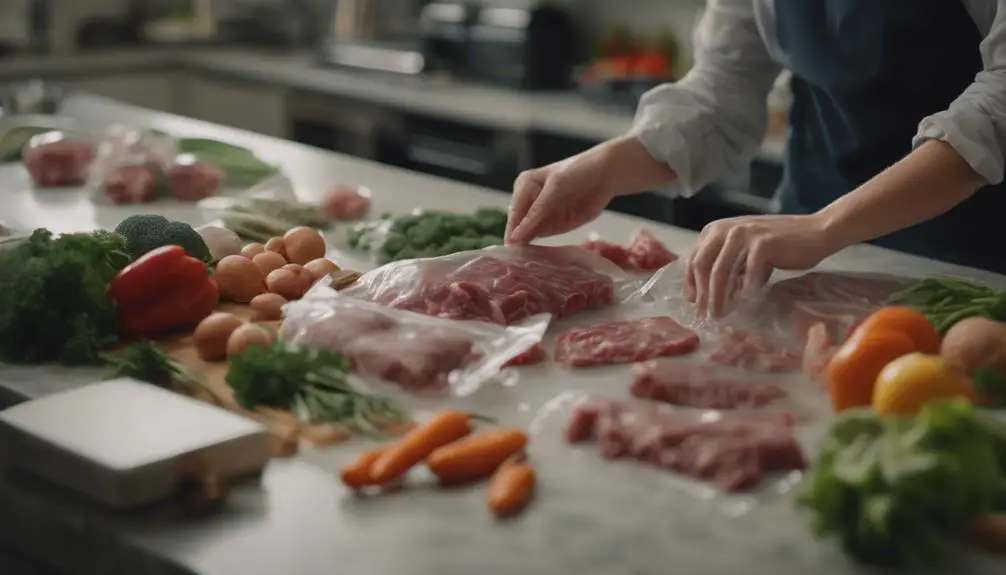
Preparing your food properly before vacuum sealing is crucial for maintaining freshness and extending shelf life. By taking the time to prep your food correctly, you can ensure that it stays in optimal condition for longer. Let's explore some essential steps to follow.
First and foremost, it's important to thoroughly wash your fruits and vegetables. This helps remove any dirt, pesticides, or bacteria that may be present. Additionally, make sure to dry them thoroughly as any excess moisture can lead to freezer burn or spoilage. Properly drying your produce is key to keeping it fresh and flavorful.
When it comes to meats, it's a good idea to trim off any excess fat and portion them into meal-sized servings. This not only makes the vacuum sealing process more efficient but also simplifies meal planning. By having pre-portioned servings, you can easily grab what you need without worrying about defrosting more than necessary.
For vegetables, blanching them before sealing is a game-changer. Blanching involves quickly boiling them and then immediately plunging them into ice water to halt the cooking process. This step dramatically slows down the enzymatic processes that cause spoilage, ensuring that your vegetables retain their texture and color. It's a simple yet effective way to preserve their freshness.
Another helpful tip is to dry herbs before sealing them. This preserves their flavor and aroma much better than freezing them fresh. Lay the herbs out on a clean towel, pat them dry, and consider using a salad spinner to remove any remaining moisture. This meticulous preparation will ensure that your pantry is stocked with high-quality, long-lasting ingredients.
The Art of Proper Sealing
Mastering the art of proper sealing is essential for turning your kitchen's food storage into a fortress against spoilage and waste. It's more than just pressing a button on a machine; it's a craft that requires attention to detail, an understanding of different foods, and the right techniques to lock in freshness.
To help you perfect your vacuum sealing technique, I've put together a quick guide:
- Preparation: Make sure your food is dry or properly blotted. This is important because any moisture can affect the sealing process and lead to spoilage.
- Bag Selection: Choose the right size bag for your food. Using a bag that's too big can result in excess air and reduce the effectiveness of the seal. On the other hand, a bag that's too small may not provide adequate space for the food.
- Placement: Leave enough space at the top of the bag. This is crucial because as the food is sealed, the air inside the bag is removed. If there isn't enough space at the top, the food may get sucked into the vacuum channel, preventing a proper seal.
- Sealing: Double seal your bags for added protection. While most vacuum sealers provide a single seal, creating a second seal can provide extra assurance that your food is tightly sealed and protected from air and bacteria.
- Checking: Inspect your bags for air pockets or leaks. After sealing, check for any remaining air pockets or leaks by gently pressing on the bag. If you feel any air escaping or notice a leak, reseal the bag.
Each step is important, and skipping any of them can result in subpar results. Paying attention to details, such as ensuring your food is dry and using the correct bag size, can significantly increase the shelf life of your food. As someone passionate about reducing waste and keeping my food fresh, I view vacuum sealing as not only a method of preservation but also as an art form.
I hope this guide helps you improve your vacuum sealing technique and make the most of your food storage. By mastering this craft, you can enjoy longer-lasting, fresher food and reduce waste in your kitchen.
Freezing and Refrigerating Tips
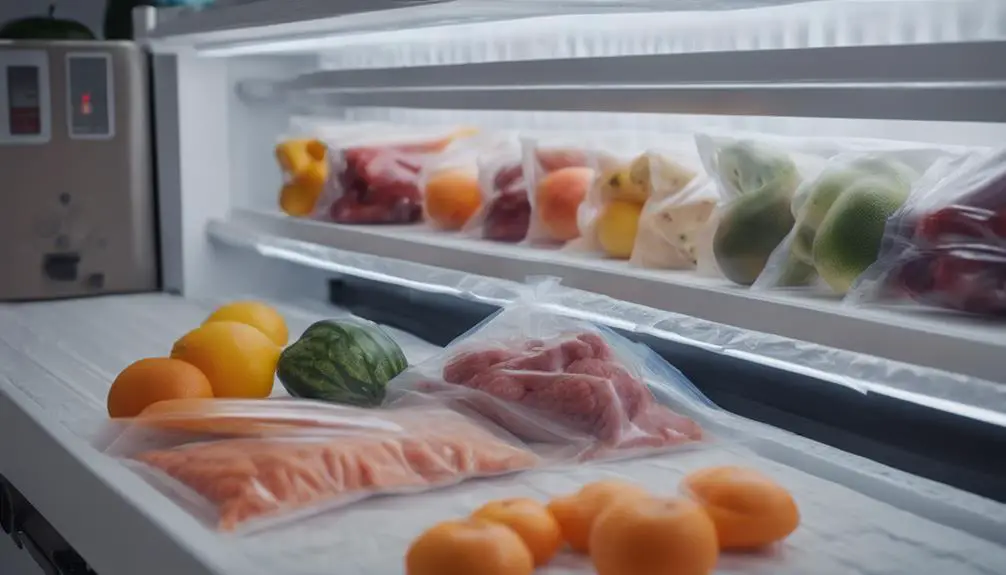
Freezing and refrigerating are essential techniques for extending the shelf life and freshness of your food. When done correctly, these cold storage methods can turn your kitchen into a sanctuary of long-lasting sustenance. Here are some tips to make the most of freezing and refrigerating:
- Before vacuum sealing, it's best to pre-freeze delicate items such as fruits, berries, and items that are prone to losing their shape. This step preserves their integrity and prevents them from turning into a mushy mess.
- Labeling is key. Make sure to clearly label everything you store, including the date. This not only helps you keep track of what's inside but also ensures optimal rotation and usage of your food.
- Avoid overfilling your containers or freezer bags. Give your food some breathing room. In the freezer, this prevents freezer burn, and in the fridge, it allows for even cooling.
- It's important to maintain a consistent temperature in your freezer and fridge. Fluctuations in temperature can shorten the shelf life of your food and compromise its quality.
- Organize your food by grouping similar items together. This not only helps with organization but also reduces the time the refrigerator or freezer door stays open, minimizing temperature changes that can affect the quality of your food.
Storing Liquids and Moist Foods
Storing liquids and moist foods can be a challenge, even for experienced home chefs. However, there are techniques you can use to preserve their freshness and flavor perfectly. One secret I've discovered is to freeze these tricky items before vacuum sealing them.
Start by pouring your soups, broths, or marinades into ice cube trays or shallow pans. Once they're frozen, remove them and vacuum seal the solid blocks. This method prevents the vacuum sealer from sucking up the liquids, which could interfere with the sealing process.
When it comes to moist foods like raw meat or cooked meals with gravy, I've a handy trick. I use a barrier between the food and the top of the bag, such as a paper towel or a piece of parchment paper. This barrier absorbs any excess moisture and ensures a tight seal, preventing any liquid from escaping into the sealer. It's a simple yet effective way to avoid messy situations and save on bags.
Organizing Your Vacuum-Sealed Foods
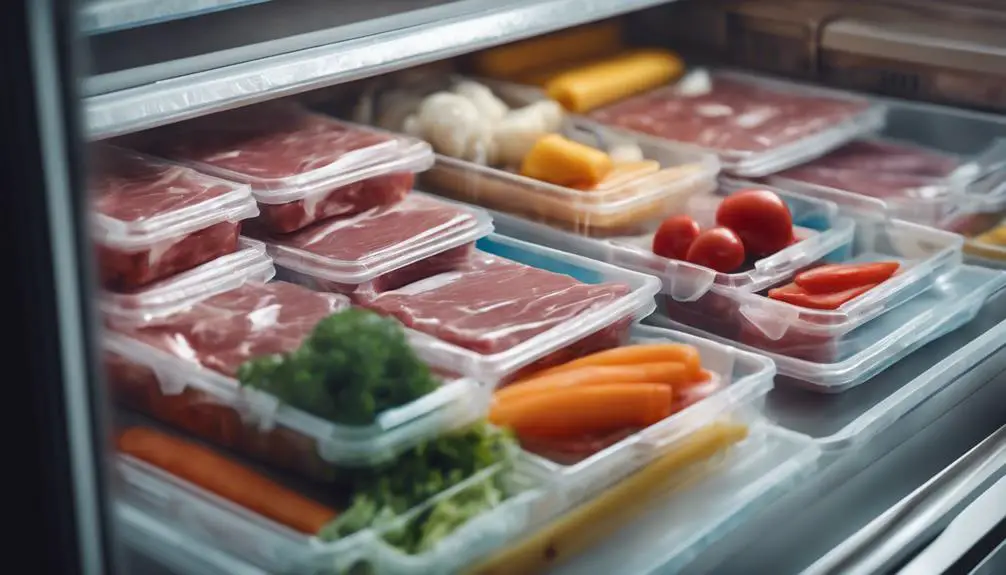
Once you've vacuum-sealed your foods, organizing them in your freezer or pantry becomes the next important step to maximize space and preserve the freshness of your provisions. By taking a systematic approach, you can keep your kitchen clutter-free and ensure that each vacuum-sealed item is easily accessible and remains in optimal condition.
To efficiently store your vacuum-sealed foods, consider the following tips:
- Label Everything: Take a moment to write the contents and date on each package. This simple step not only saves time but also prevents wastage. You'll always know what you have on hand and can easily identify when something needs to be used or replaced.
- Sort by Type: Group similar items together, such as meats with meats and vegetables with vegetables. This not only helps maintain a tidy storage space but also aids in meal planning. When everything is organized by category, you can quickly locate specific items when preparing meals.
- Use Clear Bins: Opt for transparent bins or containers that allow you to see what's inside without having to move things around. This makes it easier to locate and retrieve the items you need without disrupting the rest of your storage system.
- Keep a Log: Maintain a running list of what's stored in your freezer or pantry. This log serves as a valuable tool for meal planning and prevents unnecessary purchases. You'll always know what you have available and can plan your meals accordingly.
- First In, First Out: Practice the 'first in, first out' rule by placing newer items at the back of your storage space. This ensures that older stocks are used first, reducing the risk of freezer burn or spoilage. By rotating your inventory, you can make the most of your vacuum-sealed foods and minimize waste.
Implementing these strategies has transformed my food storage routine. Not only am I maximizing the benefits of vacuum-sealing, but I'm also enjoying the peace and order that comes with a well-organized kitchen.
Troubleshooting Common Issues
Vacuum sealing for long-term food storage has many advantages, but there are some common issues that can arise. One of the most common problems is when the vacuum sealer doesn't seal properly. This often happens when the bags are overfilled or when incompatible bag types are used. To avoid this issue, it's important to leave enough space at the top of the bag and use bags that are recommended by the vacuum sealer's manufacturer.
Another challenge is when moisture gets sucked into the vacuum sealer. This can be a problem with moist foods, but there are ways to prevent it. One solution is to pre-freeze wet items before vacuum sealing them. Another option is to place a paper towel barrier inside the bag near the seal area. This helps absorb any excess moisture and keeps the sealer clean, ensuring a tight seal.
Lastly, some people may find that their vacuum-sealed bags seem to lose their vacuum over time. This can be frustrating, but there's usually a simple explanation. Often, there are tiny punctures or wrinkles along the seal area that are allowing air to get in. To solve this problem, double-sealing the bags can provide an extra layer of protection against air intrusion.
Frequently Asked Questions
Can Vacuum-Sealing Extend the Shelf Life of All Types of Food, or Are There Exceptions?**
Vacuum-sealing can definitely help extend the shelf life of many different types of food. However, it's important to note that there are some exceptions to this rule. Foods with high moisture content, such as soups or stews, don't fare well when vacuum-sealed because the moisture can cause the food to spoil faster.
Additionally, certain types of fresh produce, like lettuce or berries, don't benefit from vacuum-sealing either. These items are best stored in breathable containers or bags to maintain their freshness.
On the other hand, vacuum-sealing can work wonders for other types of food. It can help preserve the flavor and texture of meats, preventing freezer burn and extending their shelf life. It's also great for storing dry goods like pasta, rice, or coffee, as it keeps them fresh and free from pests.
When it comes to vacuum-sealing, it's important to choose the right equipment. There are many different vacuum-sealing machines available on the market, ranging from basic models to more advanced ones. Some popular options include the FoodSaver Vacuum Sealer and the NutriChef Vacuum Sealer. These machines offer airtight sealing and are easy to use.
How Does Vacuum Sealing Impact the Nutritional Value of Food Over Time?**
Vacuum sealing is a great way to preserve the nutritional value of food over time. By removing the air from the packaging, it limits oxidation, which can lead to nutrient loss. This means that vitamins and minerals are kept intact better than with traditional storage methods. As a result, you can enjoy the benefits of fresh food for a longer period.
One of the main advantages of vacuum sealing is that it helps to retain the vitamins and minerals that are essential for our health. When food is exposed to oxygen, it can cause a breakdown of these important nutrients. However, vacuum sealing creates a barrier that prevents oxygen from reaching the food, thus minimizing nutrient loss.
For example, let's say you vacuum seal a bag of fresh vegetables. Without the oxygen, the vitamins like vitamin C and B vitamins are better preserved. These vitamins are crucial for maintaining a healthy immune system and promoting energy production in our bodies. By vacuum sealing, you can ensure that you're getting the maximum nutritional value from your vegetables.
In addition to preserving vitamins, vacuum sealing also helps to maintain the quality of minerals. Minerals such as iron and calcium are vital for various bodily functions, including bone health and oxygen transport. By limiting oxidation, vacuum sealing prevents the degradation of these minerals, allowing you to benefit from their nutritional value.
When it comes to specific product recommendations, there are several vacuum sealers available on the market that offer excellent performance. One popular option is the FoodSaver Vacuum Sealer. It's known for its reliable sealing capabilities and user-friendly design. Another highly regarded option is the NutriChef Vacuum Sealer. It offers a compact size and powerful suction, making it ideal for both home and professional use.
Are There Eco-Friendly or Biodegradable Options for Vacuum Sealer Bags?**
I have discovered that the market is now offering eco-friendly vacuum sealer bags that are biodegradable. These bags are a great option for those who are passionate about sustainability and want to reduce their environmental footprint. Not only do these bags help preserve food, but they also align with my love for the environment.
These biodegradable vacuum sealer bags are made from materials that can break down naturally over time. They are designed to minimize the impact on the environment, making them a more sustainable choice compared to traditional plastic bags.
One example of an eco-friendly vacuum sealer bag is the FoodSaver Eco-Friendly Vacuum Sealer Bags. These bags are made from recycled materials and are fully biodegradable. They are also BPA-free, ensuring that no harmful chemicals are leaching into the food.
Another option is the Nutri-Lock Vacuum Sealer Bags. These bags are made from a special type of biodegradable plastic that breaks down within a few years. They are also puncture-resistant and can withstand high temperatures, making them ideal for food preservation.
Using these eco-friendly vacuum sealer bags not only helps reduce waste but also supports a more sustainable future. By choosing biodegradable options, we can make a positive impact on the environment while still enjoying the benefits of vacuum sealing. So, if you're looking for a greener footprint in your kitchen, consider switching to these eco-friendly alternatives.
Can Vacuum-Sealed Foods Be Reheated or Cooked in Their Bags, and if So, Under What Conditions?**
Yes, you can safely reheat or cook vacuum-sealed foods in their bags, but it is important to ensure that the bags are BPA-free and heat-safe. One popular method of cooking vacuum-sealed foods is sous-vide cooking, which involves cooking the food in a precisely controlled water bath. This cooking technique ensures that the temperatures do not exceed the bag's tolerance, preventing any potential melting or damage.
Sous-vide cooking is an excellent choice for reheating or cooking vacuum-sealed foods because it allows for precise temperature control and even cooking. The food is sealed in a bag and then submerged in the water bath, where it cooks slowly and evenly. This method is particularly great for cooking tender meats, fish, and vegetables, as it helps to retain their natural flavors and juices.
When using sous-vide cooking for vacuum-sealed foods, it is essential to follow the recommended cooking times and temperatures for each specific food item. This information can usually be found in sous-vide cookbooks or online resources. Additionally, it is crucial to ensure that the bags used are specifically designed for sous-vide cooking and are labeled as BPA-free and heat-safe.
It's worth noting that not all vacuum-sealed bags are suitable for cooking or reheating. Some bags may not be designed to withstand high temperatures, and using them in cooking could lead to melting or contamination of the food. To ensure safety, always check the packaging or manufacturer's instructions to confirm that the bags are suitable for cooking or reheating.
How Does Altitude Affect Vacuum Sealing Effectiveness and Food Preservation?**
Altitude has a significant impact on the effectiveness of vacuum sealing and the preservation of food. When you're at higher altitudes, the air pressure is lower, which can affect the seal created by the vacuum sealer. This can potentially compromise the freshness and longevity of the food you're trying to preserve.
To understand why altitude matters, let's delve into the science behind it. When you use a vacuum sealer, it removes the air from the packaging, creating a tight seal that helps prevent the growth of bacteria and other microorganisms. This seal is essential for preserving the quality and taste of the food.
However, at higher altitudes, the lower air pressure makes it more difficult for the vacuum sealer to create a strong seal. The decreased air pressure can cause the packaging to expand, allowing air to seep back into the bag. This can lead to spoilage and reduce the shelf life of the food.
To overcome this challenge, there are a few things you can do. First, make sure you're using a high-quality vacuum sealer that is designed to handle the lower air pressure at higher altitudes. Look for models that specifically mention their suitability for use at higher elevations.
Second, consider using thicker and more durable vacuum sealer bags. These bags can better withstand the pressure changes at higher altitudes and provide a more secure seal. Look for bags that are explicitly labeled as suitable for use at higher elevations.
Lastly, if you're vacuum sealing delicate or perishable foods at higher altitudes, it might be worth investing in a vacuum sealer with adjustable settings. This way, you can customize the sealing process to better accommodate the specific altitude you're at.
Conclusion
When it comes to preserving food's freshness, vacuum sealing is a game-changer. I've delved deep into this art and discovered some incredible facts. Did you know that vacuum sealing can extend the shelf life of food by up to 5 times compared to traditional storage methods? It's not just about saving money; it's about embracing a sustainable lifestyle and respecting our resources.
By embracing vacuum sealing, we can create a future where we waste less and truly appreciate the abundance of our kitchens. Every time we seal our food, we take a step towards that future.
So, why is vacuum sealing so important? Well, it's all about eliminating air from the equation. Air is the enemy when it comes to food preservation. It's what causes oxidation, which leads to spoilage and the growth of bacteria. Vacuum sealing removes the air, creating a barrier that keeps food fresh for much longer.
Imagine you have a delicious steak that you want to save for a special occasion. If you were to store it in a regular bag or container, it would quickly lose its freshness and flavor. But by vacuum sealing it, you can lock in all the juices and flavors, ensuring that it stays just as delicious as the day you bought it.
Not only does vacuum sealing preserve the taste of your food, but it also maintains its nutritional value. Vitamins and minerals are sensitive to air and light, and they can degrade over time. By vacuum sealing your food, you're protecting these essential nutrients and ensuring that you're getting the most out of your meals.
To make the most out of vacuum sealing, there are a few tips you should keep in mind. First, make sure you're using high-quality vacuum sealing bags or containers. Cheaper alternatives may not provide the same level of protection and could result in freezer burn or spoilage.
Second, remember to label your sealed packages with the date and contents. This way, you can easily keep track of what you have in your freezer and how long it has been stored.
Lastly, consider investing in a reliable vacuum sealer. There are many options available on the market, ranging from handheld sealers to countertop models. Do your research and choose one that fits your needs and budget.
In conclusion, vacuum sealing is a fantastic way to extend the shelf life of your food. By eliminating air and creating a protective barrier, you can preserve the freshness, flavor, and nutrients of your meals for much longer. So, why not give it a try and embrace a more sustainable and resourceful future in your kitchen?
